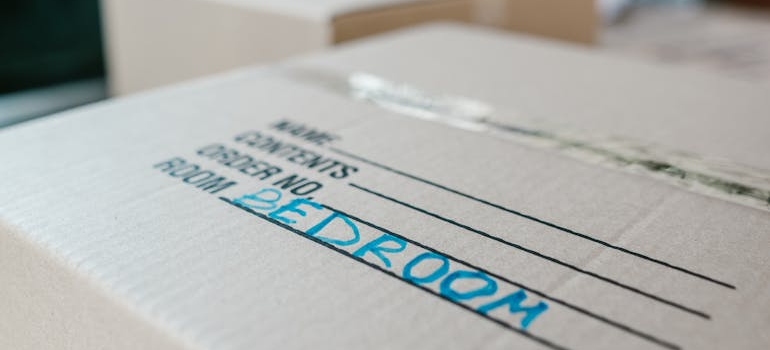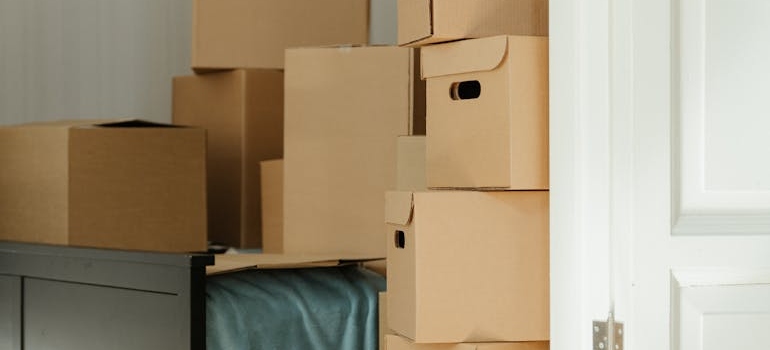Sustainable Practices for Downsizing Before Relocating
Moving gives you the perfect excuse to shed what no longer serves you, but doing it thoughtfully goes beyond simply decluttering. Imagine your downsizing efforts lightening your load and contributing to a more sustainable future. Every object you part with—whether donated, sold, repurposed, or recycled—has the potential to extend its life and reduce waste. Sustainable practices for downsizing before relocating can turn the often overwhelming task of packing up into something meaningful. So, instead of tossing things in the trash, what if you could approach your move like a resourceful strategist, minimizing what you bring while benefiting others and the planet? So, explore with Hansen Bros. Moving & Storage how you can downsize smartly before your move, all while keeping sustainability front and center.
Read more: Sustainable Practices for Downsizing Before RelocatingThe Hidden Benefits of Thoughtful Downsizing
Downsizing doesn’t just clear your physical space—it declutters your mind, too. When you consciously reduce what you own, you start to recognize what truly matters. Fewer items to manage means less time spent organizing, cleaning, and worrying about things that rarely get used. More importantly, it allows you to shift your focus to living more intentionally.
Rather than viewing downsizing as a loss, think of it as a powerful way to regain control over your life. Lightening your load for the move creates space for new experiences in your next chapter. Shedding what no longer serves you encourages you to surround yourself with things that truly add value. That’s where sustainability plays a role. This isn’t just about moving services in Seattle; it’s about making a conscious decision to live more purposefully.

The Power of Donation
Before tossing things in the trash, think about the potential impact. That couch you no longer need? It could become someone else’s favorite piece. Are those extra kitchen gadgets collecting dust? A local shelter might be thrilled to have them. Donation doesn’t just clear out your space; it creates an opportunity to make a real difference.
So, reach out to local charities, community centers, or even friends and neighbors. Many organizations will pick up larger items, making the process seamless. Donating ensures that your once-loved possessions find new homes, keeping them out of landfills and helping others.
Turning Clutter Into Cash
Got items that are still in great condition but not quite donation material? Turning them into cash is easier than ever. From online platforms like Facebook Marketplace and eBay to local garage sales, selling unused items has become incredibly convenient.
First, identify valuable items—furniture, electronics, or designer clothing—and choose the best method of selling. Clear photos and accurate descriptions are essential for online platforms. And if you prefer something more personal, host a yard sale and invite your neighbors to join in.
Selling your unused belongings is one of the sustainable practices for downsizing before relocating which offsets some moving costs. At the same time, you extend the life of these items, reducing the demand for new products and contributing to sustainability.
Simplifying Paperwork and Memories Through Digital Downsizing
Paper documents and photos can take up unnecessary space. Instead of packing boxes of paperwork, digitize these items to free up room while keeping important information and memories intact. Scanning documents and storing them securely on cloud platforms reduces physical clutter and ensures easy access whenever needed.
The same goes for old photos—creating digital albums preserves memories while minimizing the need for physical storage. Recycle or shred any unnecessary paper responsibly, making it easier to downsize without generating waste.
Repurposing: Breathing New Life Into Old Items
Some items may not be useful in their current form, but that doesn’t mean they’re at the end of their life. Repurposing is an excellent way to extend the usability of belongings that might otherwise be discarded. With a little creativity, you can turn seemingly obsolete items into something functional and new.
For example, old wooden furniture can be refinished to match your new decor, while glass jars can be used for storage or DIY projects. Worn-out clothing can be cut into cleaning rags or used in craft projects. Repurposing doesn’t just reduce waste—it gives you a chance to add a personal touch to your new space.

Repurposing old items also offers an opportunity to create something unique. Instead of throwing things out and buying new items, look around and see how you can give what you already own a second life. Therefore, to help streamline your downsizing process, here’s a quick guide on what can be repurposed or recycled, making it easier to reduce waste during your move:
- Electronics: Recycle through local e-waste programs for safe disposal.
- Glass jars: Perfect for storage, crafts, or even small planters.
- Old furniture: Sand, repaint, or reupholster to refresh the look.
- Clothing: Turn worn pieces into rags, or donate them to textile recycling programs.
- Cardboard: Use for moving, then recycle after your move.
This list serves as a reminder that many of your belongings can be transformed or reused in ways you may not have considered.
Recycling Right or What You Should and Shouldn’t Toss
Recycling is among sustainable practices for downsizing before relocating for items that can’t be donated or sold, but doing it correctly is key. Improper recycling can contaminate entire batches, sending everything to the landfill instead. Before throwing things in the recycling bin, take time to understand what’s accepted in your area.
For instance, many cities have special e-waste programs for items like electronics, batteries, and old appliances. These items require specific handling to avoid harmful environmental impacts. Paper and cardboard can often be recycled, but make sure they are clean and free from any food residue.
Plastics can be tricky, so it’s important to check your local guidelines on what types of plastics are accepted. Recycling thoughtfully helps reduce the demand for new materials, conserves natural resources, and limits the amount of waste that ends up in landfills.
Sustainable Packing: Reducing Waste as You Prepare to Move
Packing for a move doesn’t have to mean mountains of waste. Sustainable packing solutions are readily available and can help reduce the environmental impact of your relocation. Instead of relying on plastic and single-use materials, consider eco-friendly alternatives.
Biodegradable packing peanuts, recycled paper, and reusable moving boxes in Seattle offer great alternatives to traditional packing supplies. You can also rent reusable moving bins from companies specializing in sustainable moves. Local grocery stores or friends may have extra boxes to offer, cutting down on the need to buy new ones.
Fragile items can be protected using towels, linens, or even clothing, eliminating the need for bubble wrap. These small changes can make a big difference in reducing waste, and they also save money.

Adopting a Minimalist Mindset: Less Is More
When downsizing, a minimalist mindset can guide you through the process. Minimalism doesn’t mean getting rid of everything you own, but rather being intentional with what you keep. Ask yourself whether an item serves a clear purpose or brings you joy. If it doesn’t, it might be time to part ways.
The beauty of minimalism lies in simplicity. Owning fewer things doesn’t just free up space; it gives you more freedom and flexibility. Instead of worrying about where to store everything, you can focus on what truly matters in your new home. Minimalism isn’t just for the moving process—it’s a lifestyle choice that can improve your quality of life long after the move is completed.
Leveraging Local Resources in the Seattle Metro Area
If you’re moving within or around the city with local movers in Seattle, you have access to many local resources that can help you downsize sustainably. Seattle is known for its eco-conscious community, making it easy to find organizations that can help you donate, recycle, or even repurpose your belongings.
Consider checking out local organizations like Seattle Goodwill for clothing and household donations or The Big Blue Truck for easy book and media drop-offs. You can also utilize Ridwell, a Seattle-based service that helps households responsibly dispose of hard-to-recycle items such as electronics, textiles, and light bulbs.
Smart Waste Disposal When There’s No Other Option
Sometimes, no matter how hard you try, some items simply can’t be sold, donated, or repurposed. In these cases, it’s essential to dispose of them responsibly. Items like hazardous home materials—batteries, paint, or certain electronics—require special disposal procedures to prevent environmental harm.
Look for local collection events or waste facilities that handle these items safely. In the Seattle metro area, facilities like Household Hazardous Waste offer drop-off services for materials that shouldn’t go into the regular trash.
For larger items like old furniture or mattresses, many cities offer bulk item collections or partnerships with sustainable disposal companies. Some moving companies also provide eco-friendly disposal options as part of their services, ensuring that items are handled properly.
Downsizing With a Strategy
The best sustainable practices for downsizing before relocating include planning well in advance. Don’t wait until the last minute to start sorting through your things. Create a plan that tackles one room at a time, giving you space to make thoughtful decisions. Having a strategy with a timeline prevents the rush of throwing things away just to save time:
- 6 weeks before the move: Begin sorting through each room, starting with the least-used spaces like storage areas or guest rooms. Identify items to sell, donate, recycle, or keep.
- 5 weeks before the move: List valuable items for sale on online platforms or plan a garage sale. Schedule pick-ups for large donation items with local charities.
- 4 weeks before the move: Continue sorting through main living spaces. Organize paperwork, start digitizing important documents, and recycle any unnecessary files.
- 3 weeks before the move: Finalize donations. Drop off recyclable electronics at e-waste facilities. Begin packing non-essential items using eco-friendly packing materials.
- 2 weeks before the move: Focus on downsizing clothes and personal items. Donate what you no longer need and pack seasonal or rarely used clothing.
- 1 week before the move: Complete any final sales, recycling drop-offs, and donations. Pack the remaining essentials and double-check your inventory to ensure nothing is left behind.
Set clear goals for each week leading up to your move with your Washington movers, whether that’s selling unused furniture, donating clothes, or digitizing paperwork. Spacing out these tasks will reduce stress and help you make better decisions about what to keep and what to part with. This also allows you to arrange donation pick-ups or schedule recycling drop-offs well in advance.

Moving Day: Packing Light, Moving Right
By the time your moving day arrives, all the effort you put into downsizing will pay off. A lighter load means fewer trips, lower moving costs, and a more organized moving experience. Beyond that, you can feel confident knowing that your approach to downsizing has made a positive environmental impact.
Transporting fewer items also contributes to fewer emissions. With less weight and fewer boxes to carry, moving trucks consume less fuel, which reduces the carbon footprint of your relocation. In some cases, a smaller vehicle may even be sufficient, further cutting down on emissions.
This isn’t only about making your move easier but setting the scene for sustainable living in your new home. You’ve managed to minimize waste, recycle correctly, support your local community, and choose a lifestyle that aligns with your values. That’s what moving responsibly looks like.
A Sustainable Path Forward
Downsizing before relocating is more than just a practical task—it’s an opportunity to rethink your relationship with your belongings and the environment. Every item you sell, donate, recycle, or repurpose contributes to a more sustainable future. As you settle into your new home, carry this mindset forward.
Your choices matter, and the more thoughtful you are about them, the greater the impact you’ll have on both your personal life and the world around you. Applying sustainable practices for downsizing before relocating doesn’t end when the move is over. It’s a lifelong commitment that starts with the choices you make right now.
Why Choose Us
History
Hansen Bros. Moving & Storage is locally owned and operated by the same family for four generations, since 1890. We have a well-established reputation for service quality and reliability with a high percentage of repeat household and commercial clients.
Professionalism
We’re a certified ProMover by the American Moving and Storage Association with A+ rating with the Better Business Bureau, voted “Best in Western Washington” in 2009 and from 2011 to 2016 by KING5. Our company is fully licensed and insured and member of WMC and AMSA.
Value
Hansen Bros. Moving & Storage provide free, no-obligation in-home estimate and competitive rates, including low minimum rates for shipments moving under 300 miles. We’ve set a refund policy for unused packing materials and three Puget Sound locations to help clients save on travel fee costs.



